
Full text of Chemistry 2e from OpenStax in a form suitable for importing to Brightspace/D2L

Full text of Chemistry 2e from OpenStax in a form suitable for importing to Brightspace/D2L
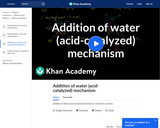
This 13-minute video lesson considers the addition of Water (Acid-Catalyzed) Mechanism. [Organic Chemistry playlist: Lesson 29 of 73].

This video shows different chemical reactions which can make things interesting and look like magic. The name of the chemicals is also given using which everyone can learn.
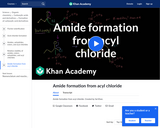
This 9-minute video lesson looks at amide formation from acyl chloride. [Organic Chemistry playlist: Lesson 72 of 73].
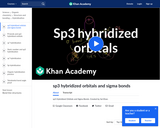
This 16-minute video lesson looks at sp3 hybridized orbitals and sigma bonds. [Organic Chemistry playlist: Lesson 13 of 73].

This 14-minute video lesson looks at Pi bonds and sp2 Hybridized Orbitals. [Organic Chemistry playlist: Lesson 14 of 73].

In 1950, Percy Julian was one of the few African Americans with a Ph.D. He was Chicago's man of the year and a groundbreaking scientist. But it wasn't an easy road. Denied teaching positions and the target of death threats, Julian struggled to get ahead in a racially hostile world. Learn more about Percy Julian's contributions to science and civil rights. These resources, adapted from NOVA: Forgotten Genius, explore how Julian revolutionized chemistry with the first synthesis of a chemical compound, as well as the challenges he overcame as an African American facing legalized segregation.

An elementary introduction to chemistry vocabulary, tools and concepts used in science curriculum.

Enantiomers have almost all the same chemical and physical properties, so it can be tough to separate them. But it’s still super important that we know how to tell them apart! In this episode of Crash Course Organic Chemistry, we’ll recap all the types of isomers we’ve learned about so far, and also learn about polarimetry as a way to separate enantiomers and how to predict the number of stereoisomers a molecule will have.
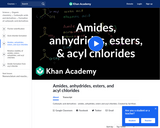
This 9-minute video lesson looks at carboxylic Aacid Derivatives: amides, anhydrides, esters and acyl chlorides. [Organic Chemistry playlist: Lesson 70 of 73].

Things have been getting more and more complicated here in Crash Course Organic Chemistry, and as we deal with more complex molecules, parts of molecules we don’t want to react will start reacting along with the parts that we do. Luckily, we have protecting groups, which act like a chemical disguise and help us control how molecules react. In this episode, we’ll look at what makes a good protecting group, as well as identify some good protecting groups for different functional groups. We’ll also see what role protecting groups play in the synthesis of penicillin!

Learning to talk about chemistry can be like learning a foreign language, but Hank is here to help with some straightforward and simple rules to help you learn to speak Chemistrian like a native.
Chapters:
Determining Formulas and Names of Monatomic Ions
Finding Cation-and Anion Forming Elements on the Periodic Table
Writing Formulas and Naming Transition Metals
Naming Acids and their Anions

The organic molecules that make up life on Earth are more than just the 2-D structures we’ve been drawing so far. Molecules have 3-D shapes that help us understand what they can do. In this episode of Crash Course Organic Chemistry, we’ll learn how orbital hybridization and valence bond theory can help us explain 3D molecular structures and about constitutional and geometric isomers.
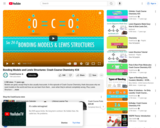
Models are great, except they're also usually inaccurate. In this episode of Crash Course Chemistry, Hank discusses why we need models in the world and how we can learn from them... even when they're almost completely wrong. Plus, Lewis Structures!
Chapters:
Models
Linus Pauling & The Bonding Model
Lewis Dot Structures
Ionic Bonds
Covalent Bonds
Double Bonds
Triple Bonds
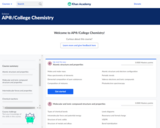
Khan Academy offers practice exercises, instructional videos, and a personalized learning dashboard that empower learners to study at their own pace in and outside of the classroom. We tackle math, science, computing, history, art history, economics, and more, including K-14 and test preparation (SAT, Praxis, LSAT) content. We focus on skill mastery to help learners establish strong foundations, so there's no limit to what they can learn next!
Mastery Lessons:
• Atomic structure and properties
• Molecular and ionic compound structure and properties
• Intermolecular forces and properties
• Chemical reactions
• Kinetics
• Thermodynamics
• Equilibrium
• Acids and bases
• Applications of thermodynamics

You may know that cows produce methane, which is a big concern when it comes to global heating, but did you know that organic chemistry provides a potential solution to this problem? Feeding cows small amounts of red seaweed can greatly reduce methane emissions, in part due to organic chemicals called enols! In this episode of Crash Course Organic Chemistry, we’ll learn all about enols and enolates, their reactivity, and reactions we can do with them including halogenation and alkylation.

This week, Hank elaborates on why Fugu can kill you by illustrating the ideas of solutions and discussing molarity, molality, and mass percent. Also, why polar solvents dissolve polar solutes, and nonpolar solvents dissolve nonpolar solutes. All that plus Henry's Law and why Coke = Burps.
Chapters:
Molarity, Molality, and Mass Percent
Polar Solvents Dissolve Polar Solutes
Nonpolar Solvents Dissolve Nonpolar Solutes
Henry's Law
Coke=Burps
--

Ketones and aldehydes are all around and inside us, from the strong smelling component of nail polish remover, acetone, to hormones in our bodies, to drug treatments for allergies, COVID-19, and even cancer! We’ve already learned a bit about aldehydes and ketones in this series, so in this episode of Crash Course Organic Chemistry, we’ll review some of that knowledge and start to go even deeper.

Oxygen is pretty dang amazing! Some of the most intensely studied functional groups in organic chemistry have oxygen atoms. In this episode of Crash Course Organic Chemistry, we're building on the last episode's discussion of nomenclature by learning about IUPAC's naming rules for even more functional groups.
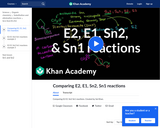
This 12-minute video lesson compares E2, E1, Sn2, and Sn1 Reactions. [Organic Chemistry playlist: Lesson 41 of 73].